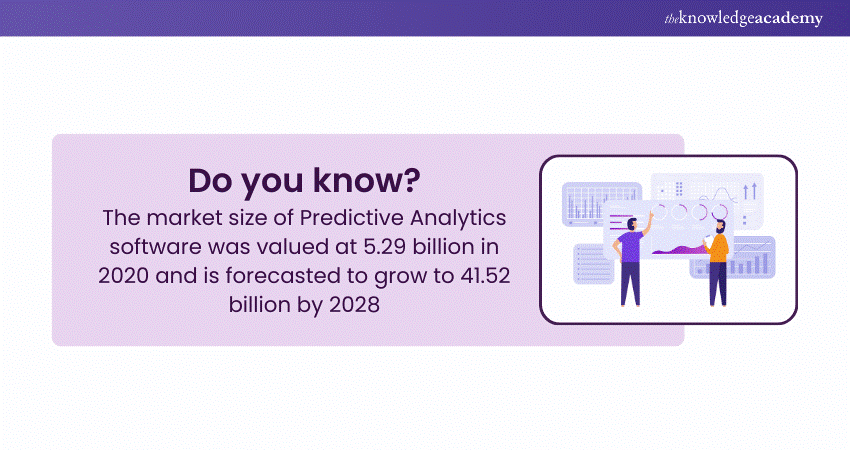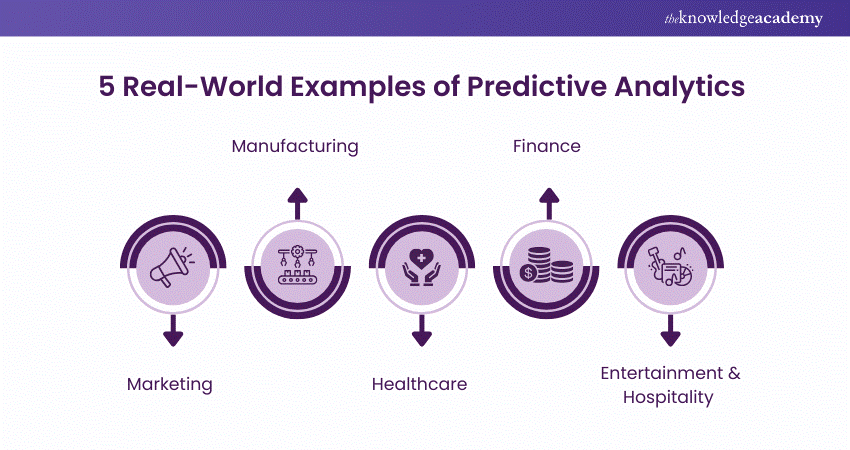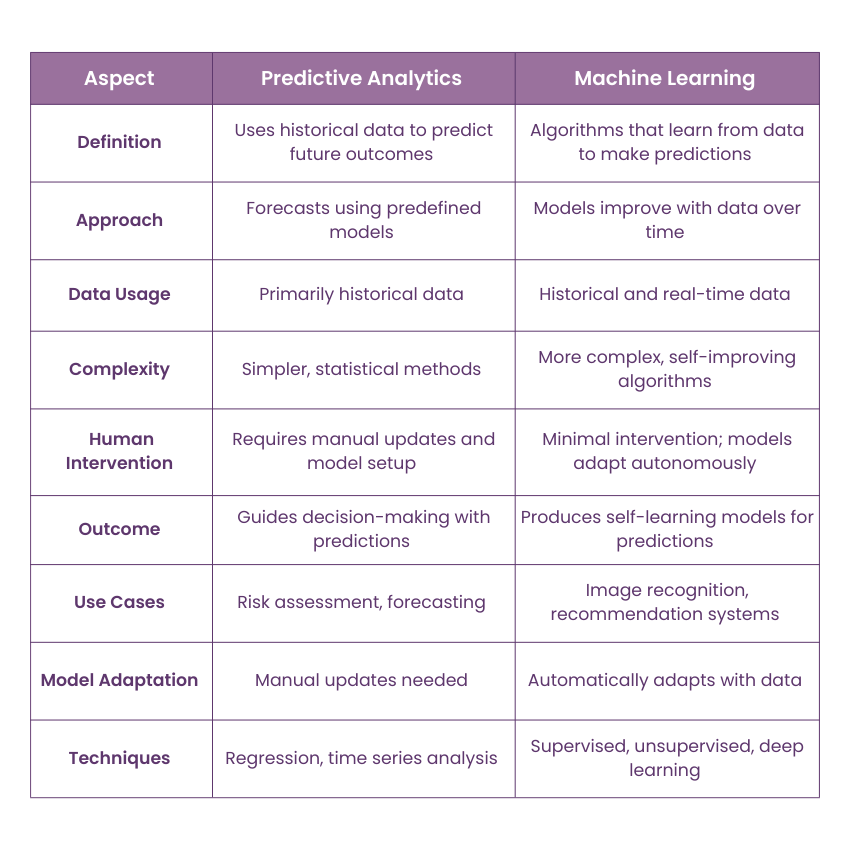We may not have the course you’re looking for. If you enquire or give us a call on +47 80010068 and speak to our training experts, we may still be able to help with your training requirements.
Training Outcomes Within Your Budget!
We ensure quality, budget-alignment, and timely delivery by our expert instructors.

Imagine forecasting the future of your company by foreseeing market trends, customer actions, and potential risks accurately. This demonstrates the strength of Predictive Analytics. This blog will give deep insights into its definition, its various types of models, and real-life proofs that highlight its competency to turn data into useful observations for making informed decisions.
Predictive Analytics is the method of using factual data, numerical algorithms, and Machine Learning techniques to predict future outcomes. By analysing trends and patterns in data, businesses can make better diagnosis by forecasting future outcomes. From predicting customer behavior and market cycle to improving supply chain performance and eliminating risks.
Table of Contents
1) What is Predictive Analytics?
2) How Predictive Analytics Operates?
3) Different Types of Predictive Analytical Models
4) 5 Real-world Examples of Predictive Analytics
5) Benefits of Predictive Analytics
6) Difference Between Predictive Analytics and Machine Learning
7) Conclusion
What is Predictive Analytics?
The fundamental objective of Predictive Analytics is to predict future conditions through advanced data Analytics. In the business sector, the merger of Data Science aligns with the development of Big Data systems, increasing data mining capabilities by utilising diverse data sets to predict insights. Advancements in Machine Learning with Big Data have expanded its range and abilities.
The rise of Predictive and Augmented Analytics aligns with the expansion of Big Data systems, allowing for more extensive data pools for enhanced data mining in order to deliver Predictive insights. Progress in Big Data Machine Learning has also contributed to the expansion of Predictive Analytics capabilities.
How Predictive Analytics Operates?
Data Scientists utilise Predictive models to discover relationships between various elements within chosen datasets. After gathering data, a statistical model is created, trained, and adjusted to make predictions.

The workflow for building Predictive Analytics frameworks follows five basic steps:
Define the Problem
a) Clarify the Objective: Begin with a clear thesis or hypothesis to guide the analysis.
b) Identify Key Questions: Examples include:
i) Can the model detect fraudulent activity?
ii) What are the optimal inventory levels for peak seasons?
iii) What are the potential flood risks from extreme weather?
c) Select the Appropriate Method: Determine the predictive approach (e.g., classification, regression) based on the problem to be addressed.
2) Acquire and Organise Data
a) Identify Data Sources: Utilise historical records, real-time streams, or both.
b) Assess Data Relevance: Ensure the data aligns with the problem being addressed.
c) Organise Data: Arrange datasets into a storage system, such as BigQuery or other data warehouses, ensuring easy access for analysis.
3) Pre-process Data
a) Clean the Data: Address missing values, inconsistencies, or errors in the dataset.
b) Eliminate Outliers: Remove extreme anomalies caused by measurement or input issues.
c) Standardise and Transform: Format the data consistently, applying necessary transformations (e.g., scaling, normalisation).
4) Develop Predictive Models
a) Select Tools and Techniques: Choose methods such as:
b) Machine Learning (e.g., neural networks, clustering).
c) Regression Models (e.g., linear or logistic regression).
d) Decision Trees (e.g., random forests).
e) Train the Model: Use training datasets to teach the model patterns and relationships.
f) Fine-tune Parameters: Optimise hyperparameters to enhance model performance.
5) Validate and Deploy Results
a) Test Model Accuracy: Validate the model using test datasets to ensure precision.
b) Iterate and Improve: Adjust the model based on validation feedback.
c) Share Results: Present findings through:
d) Interactive dashboards.
e) Integrated apps or websites.
f) Reports tailored to stakeholders' needs.
Different Types of Predictive Analytical Models
Mainly there are five common approaches used in Predictive Analytics: Regression Analysis, Neural Network Models, Clustering Techniques, Time Series Analysis and Decision Tree Models.
1) Regression Analysis
What is Regression Analysis? This model is the most commonly utilised in statistical analysis. Employ it for uncovering patterns in extensive datasets where there exists a linear correlation among the variables. This technique operates by determining a formula that illustrates the connection among all the inputs present in the dataset.
Decode Complex Data Trends: Elevate Your Skills in Regression Analysis Training Register Now!
2) Neural Network Models
Neural networks were created to minimise the functionality of the human brain for Predictive analysis. This model has the capacity to handle intricate data connections using both artificial intelligence and pattern recognition
3) Clustering Techniques
Clustering involves grouping together data with common characteristics. For instance, Amazon.com can group sales by the number of items bought or by the average length of time customers have had their accounts. By categorising data by common attributes, analysts can discover additional traits that determine upcoming actions.
4) Time Series Analysis
Sometimes, data is linked to time, and certain Predictive Analytics depend on the connection between events and their timing. These models evaluate inputs at various frequencies like daily, weekly, or monthly intervals. Next, analytical models can detect seasonal variations, trends, or patterns in behaviour by analysing timing.
This specific Predictive model aids in forecasting when peak customer service periods or surges in sales can be anticipated.
5) Decision Tree Models
This model categorises data into various segments based on specific factors like price or market capitalisation. It appears similar to a tree with separate branches and leaves, as the name suggests. Branches symbolise the options that are possible, and each individual leaf signifies a specific choice.
Understanding decision trees and breaking them down is straightforward. They come in handy when you require prompt decision-making.
Branch Out Your Skills with Decision Tree Modeling Using R Training for Smarter Insights Register Now!
5 Real-world Examples of Predictive Analytics
Here are some of the real-world examples of Predictive Analytics:

1) Marketing
In the field of marketing, a large amount of consumer data is used to develop content, ads, and tactics that can effectively target potential customers in their preferred locations. Engaging in Predictive Analytics involves analysing historical behavioural data to forecast future events.
Forecasting sales trends in marketing using Predictive Analytics can help in planning campaigns for different times of the year.
2) Manufacturing
For example, within the manufacturing industry, algorithms can be taught using past data to predict with precision when a piece of equipment is expected to break down. If the conditions for a future issue are satisfied, the algorithm will be activated to notify a worker who can halt the equipment and possibly prevent the company from incurring significant product and repair expenses.
This assessment anticipates breakdown situations right now instead of in the distant future.
3) Healthcare
In healthcare, Predictive Analytics involves utilising past data, machine learning algorithms, and statistical techniques to predict future results and patterns.
By examining previous healthcare information, Predictive analytics helps healthcare professionals predict patient requirements, enhance treatment approaches, and increase efficiency within medical facilities.
4) Finance
All businesses must maintain regular financial records, and Predictive Analytics can significantly impact predicting your company's future well-being. By utilising past financial records and information within the broader industry, you can forecast future sales, revenue, and expenses to create a vision of what lies ahead and accurately make choices.
5) Entertainment & Hospitality
Various factors influence the number of staff members needed at a venue or hotel, which affects customer influx and outflux in entertainment and hospitality. Having too many employees is expensive while having too few can lead to negative customer interactions, exhausted staff, and costly errors.
Benefits of Predictive Analytics
Following are the benefits of Predictive Analytics:
1) Enhanced Decision Making: Provides data-based insights, enabling businesses to make better-informed decisions.
2) Improved Risk Management: Assists in recognising possible risks and preventing them from happening.
3) Enhanced Efficiency: Improves operations by forecasting demand, inventory requirements, and resource distribution.
4) Enhanced Productivity: Streamlines the examination of Big Datasets, decreasing the time needed for manual analysis.
5) Improved Understanding of Customers: Predicts customer preferences and behaviour to tailor personalised marketing strategies.
6) Cost Savings: Anticipatory analysis minimises wasteful expenses by optimising resource utilisation and concentrating on pertinent opportunities.
Difference Between Predictive Analytics and Machine Learning
Predictive Analytics and machine learning terms are frequently interchanged, as they share similar objectives, yet they differ:
Machine learning tools recognise patterns in data sets and improve prediction accuracy over time, while Predictive Analytics tools utilise Predictive models for more precise event forecasting, like advertisement campaign outcomes.

Conclusion
Predictive Analytics includes past data to predict future results, helping businesses in making more informed choices. By utilising models such as regression, decision trees, and neural networks, it assists in enhancing operations and predicting trends in different industries. With the increase in data, Predictive Analytics will become increasingly essential for generating insights and fostering innovation.
Forecast the Future: Gain Expertise in Predictive Analytics Course Sign up Now!
Frequently Asked Questions

Predictive Analytics encounters obstacles such as maintaining data integrity, ensuring model precision, and preventing prejudice. Specialised knowledge is necessary and data privacy issues are raised. User trust and transparency of the model are essential, requiring regular model updates.

The goal of Predictive analysis is to predict future results by analysing present and past data trends. Assisting businesses in making well-informed decisions, streamlining operations, and predicting trends, ultimately enhancing strategic planning and increasing overall efficiency.

The Knowledge Academy takes global learning to new heights, offering over 30,000 online courses across 490+ locations in 220 countries. This expansive reach ensures accessibility and convenience for learners worldwide.
Alongside our diverse Online Course Catalogue, encompassing 19 major categories, we go the extra mile by providing a plethora of free educational Online Resources like News updates, Blogs, videos, webinars, and interview questions. Tailoring learning experiences further, professionals can maximise value with customisable Course Bundles of TKA.

The Knowledge Academy’s Knowledge Pass, a prepaid voucher, adds another layer of flexibility, allowing course bookings over a 12-month period. Join us on a journey where education knows no bounds.

The Knowledge Academy offers various Data Science Courses, including the Predictive Analytics Course and Practitioner Course, and the Advance Data Science Certification. These courses cater to different skill levels, providing comprehensive insights into Data, Analytics & AI.
Our Data, Analytics & AI Blogs cover a range of topics related Data Analytics, offering valuable resources, best practices, and industry insights. Whether you are a beginner or looking to advance your Analytical skills, The Knowledge Academy's diverse courses and informative blogs have got you covered.
Upcoming Data, Analytics & AI Resources Batches & Dates
Date
 Predictive Analytics Course
Predictive Analytics Course
Thu 9th Jan 2025
Thu 6th Mar 2025
Thu 8th May 2025
Thu 3rd Jul 2025
Thu 4th Sep 2025
Thu 6th Nov 2025







 Top Rated Course
Top Rated Course



 If you wish to make any changes to your course, please
If you wish to make any changes to your course, please


